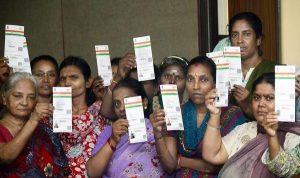
In the United States, your identity can be proven with a passport or a driver’s license — most importantly, your social security number. This nine-digit code identifies you; you need it to be able to work, open a bank account, go to school.
Now, imagine if that code was linked to your physical description. Brown hair. Brown eyes. Light skin. Seems like a driver’s license, right? Now it is hooked to your fingerprints. Similar to a passport? Now, it is associated with an eye scan. Yes, this ultra-ID is the kind you will see in Mission Impossible or The Incredibles, except that now it is a part of Indian residents’ identities.
This is the innovative new identification system that India has implemented to keep a record of the approximately 1.3 billion people in the country, four times the entire population of the United States in a third of the size. The Aadhaar card, almost a social security number 2.0, takes identification to the next level. It combines digital technology with the challenge of a nationwide headcount. But that’s not the innovative part. What’s truly novel is that it takes on the problem of tax evasion, an issue that has been rampant in India simply because there is no way to track who owes taxes.
Tax collection has been a decades long problem in India, the largest democracy in the world. Without a streamlined process of creating businesses and operating them, it has become increasingly common to open a business in India, but under a fictitious name. In doing so, profits are still made, but the operating taxes are charged to an unknown person, one that might not even exist. What’s worse is that the government is missing out on billions of dollars in taxes, funds that could fix many infrastructure issues within the nation. But now, to work, start a business, carry out financial transactions, or store profits in a bank, you need the Aadhaar card. Without it, there is little that you can do. All of a sudden millions of people are not only accounted for, but held accountable. Corrupt actions can be traced back to the individual at fault, and that citizen can in turn be held responsible in court.
However, a critique of the system has been whether this collection of information is an invasion of privacy. After all, the institution of the Aadhaar card is as if secret intelligence organization-level files on every national citizen have suddenly been made available for use in every government department, not to mention banks all over the country of India. You even need it to get a new phone number.
On the other hand, it makes many processes much more efficient for the government, namely welfare. Indians on government welfare programs can now get benefits like school-paid meals more easily. It has given them the chance to actually take advantage of the welfare and potentially get much needed help. For others with more resources, the Aadhaar card is said to even make it possible one day to pay for something with just a fingerprint scan. It is forming the basis of every Indian’s identity on paper.
After all, ‘aadhaar’ means ‘foundation’, and that is exactly what the initiative has given India. It has not only made things more economical and more structured, but it has given an identity to citizens that the government did not even know existed simply because they lived below the poverty line or in rural communities.
The question then is if the information can be used for good. Or does this put an entire population in danger of overexposure especially in a digital age? We’ll just have to wait and see. But for now, India can proudly say it is on the forefront of the latest biometric technology.
















